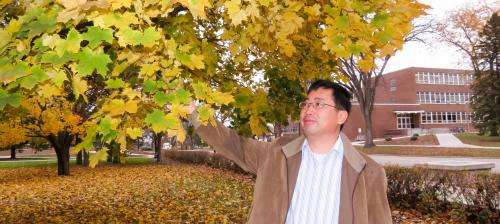Satellite images keep tabs on fall foliage

Catching the fall foliage at its peak in the United States just became a little easier, thanks to the work of senior scientist Xiaoyang Zhang of the Geospatial Sciences Center of Excellence at South Dakota State University.
He and research scientist Yunyue "Bob" Yu of the National Oceanic and Atmospheric Administration (NOAA) developed a method to monitor and predict changes in leaf coloration using satellite imagery. Maps available at noaa.gov/star/news2014_201410_FallFoliage.php" target="_blank">www.star.nesdis.noaa. … 1410_FallFoliage.php show the current foliage status and predict what will happen in 10 days. The first images were posted Oct. 15.
Previously, fall foliage information was based on field observations, Zhang explained. "We are the first to use satellite imagery to observe the fall colors and make predictions." The information is updated every three days using data from the Visible Infrared Imager Radiometric Suite (VIIRS) on the Suomi National Polar-orbiting Parnership satellite launched in October 2011.
This research is part of a larger effort to document how a changing climate affects the timing of the vegetation seasons across the world using environmental satellite data, according Zhang. The work, which began in July 2013, is supported by a three-year NOAA grant for nearly $348,000.
This research can help farmers time planting by predicting spring green-up and monitoring when drought may occur, Zhang explained. It can also help foresters detect forest changes, including disease outbreaks from forest pests.
Zhang and his colleague plan to expand their online monitoring system and increase the spatial resolution and geographic coverage of the images. "We will extend this work globally with a pixel size of 500 meters," Zhang said.
This visual image of the changing seasons may help the public gain a greater understanding of year-by-year foliage changes that might over time give them a wider view of climate change, Zhang pointed out.
Provided by South Dakota State University





















